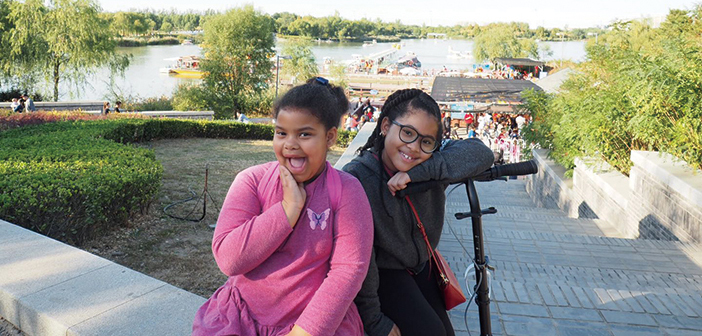Brooke and Aeijaha are best friends at a Chinese private school in Beijing.
Brooke is 8 years old, in the second grade, and has lived in China since she was in kindergarten. When she smiles her whole face lights up, with that light and joy moving from the corner of her mouth and spreading to her eyes and the rest of her face.
Aeijha (pronounced similar to Asia) is 9 years old, in third grade, and drips confidence behind her cool glasses and hair, which looks amazing no matter how she styles it. Aeijha just moved to Beijing last year, after being born and raised in Thailand.
Both are the children of expatriate teachers and both have faced bullying for their appearance here in China, a problem encountered by many expat children in a seemingly homogeneous society. Their appearance is unfamiliar to the average Chinese family, and often local children, teachers, and parents struggle to relate to those from a diverse background.
Brooke’s mother, Mel Williams, first thought her daughter was having difficulty due to being new in China. “I happened to look out the window of my classroom and saw that she was on the playground and no one else would play with her. She wasn’t crying, she was sliding and playing by herself, but no one would play with her.”
That day when Williams picked her up from school, Brooke confirmed that no one would play with her. “I told her that it was OK and that we were new to China.” But as the year progressed, Brooke still wasn’t making any friends. “It took a while, but once she learned a little bit of Chinese, then she started to make a few more friends.”
“She went through that in both kindergarten and first grade. I had to speak to the teacher when kids started to bully her. They would walk by her desk and snatch things, then rip them up. Their solution was to separate these children from her.”
That didn’t really solve the problem, as Brooke would continue to come home and tell Williams she was being bullied. Then Brooke began to fight back.
“Other teachers would come to me and say that she kicked somebody or that she pushed somebody down the stairs,” Williams explained.
Williams feels it doesn’t matter if the school is international or not, and in some ways, she found that it was worse in the international school, where children seemed to be “cliquish.” She suspects the root issue here is that when children grow up inside the same circles, they aren’t comfortable with making friends outside of their normal social circle.
Williams’ main tactic as a parent has been to help Brooke use her voice and to treat others with kindness. “I’ve told her that she has to use her voice, because she has one. She needs to tell people the things that she doesn’t like, and if it doesn’t stop, she can find something else to do. And if someone is bullying her, she can tell someone and ask for help. I would tell Brooke to always be polite and to introduce herself to people.”
Brooke had a better year in first grade when there were other expatriate children in the classroom. Issues remain with a handful of students who are not accustomed to non-Chinese peers, and these students will at times seek to be negative toward her.
Aeijha told me her parents have a similar response. They told her “treat people as you want to be treated,” and to rise above the bullying.
Besides simply looking different to peers, another issue of bullying is hiding behind language, when a peer is unaware that the girls can understand them. Williams told us: “I just reported to the teacher for the second time that a boy had been picking on her in class, not realizing her Chinese is actually really good. He tried to deny that he was picking on her, but another child confirmed it.”
During Aeijha’s interview, she confirmed that hiding behind language is an issue, and that in her own bullying experience when a group of older boys had made fun of her, calling her “fat,” they didn’t know she could understand them until the boys were confronted by the Student Affairs office. The principal required these students to apologize, but Aeijha felt the apology was inauthentic and “it really didn’t help.” When asked why, she explained they clearly were being forced. The only incident of bullying she experienced in Thailand at the International School of Bangkok was followed by a sincere apology from the student.
For Brooke, talking about bullying was much harder, and she wanted to present to me a picture of a strong girl who ignored bullying and dealt with problems herself. As we went through questions, Brooke would give Williams a look of, “I’ve got this. No, I’m not sharing that story.” Brooke began to tear up when she shared what her teacher said after a bullying incident, “My teacher said, I am perfect the way I am. It makes me confident that I can deal with these problems.”
Williams’ suggestions for schools and teachers is to offer sensitivity training so students have expectations laid out for them of how to treat others from diverse backgrounds. Teachers need to be on the lookout for signs of bullying. “For parents, they need to build their child’s self-esteem if you’re choosing to live abroad in an unfamiliar place, especially if local children are not open to expats.” She encourages parents to talk to their children about people who are different and how to have friends who are different. She has noticed that any child who is “different” can cause other children to make fun, as she has witnessed this with overweight Chinese children and an Autistic Chinese child.
Preston Thomas, currently employed at RDFZ Chaoyang Branch School as a Senior English Teacher, has lived in China for eight years and witnessed bullying due to differences while at his last international school, where the makeup of students was more heterogeneous.
“One incident was because the student was… half Chinese and half Australian; he was ridiculed because he was not fully Chinese and his Mandarin was not good enough. He was also insulted because his parents were divorced. Other incidents I saw were Chinese students insulting each other for darker skin tones.”
Thomas confronted this issue and others like it by talking to the students being bullied for both comfort and encouragement, but by also using the opportunity to explicitly teach about diversity.
“When students were judging other students based on skin color, I actually made it a point to make a lesson devoted to diversity. I told them that if they practice this behavior abroad, people won’t take it lightly. I reminded them, they are all citizens of the world. They will meet many different people from many walks of life and by judging solely by skin color is racist. Also, it is highly offensive and someday they might be the victims if they continue this behavior.”
Parents were not contacted in any of the cases, and the school overall did not offer support to teachers, students, or parents in dealing with either bullying nor diversity. Instead, teachers would talk among one another to make sure if a particular student was being targeted, they could all be on alert and address any incidents that might arise.
Thomas suggested for teachers, “One great resource, although dated, is A Class Divided. It is a great resource to promote diversity and understanding especially in younger kids, as it touches on race and passing judgment based on skin color.”
For parents, Thomas stressed the importance of being in the lives of children, asking questions and making sure the child feels comfortable talking. It is also important to know who friends are and to sometimes ask difficult questions, especially if a parent might suspect their child is bullying someone else. “Finally, don’t pass judgment. Give them the reasons why it is wrong to target someone, don’t just yell at them.”
While interviewing both girls, I couldn’t help reflect how my own children have fared in a Chinese private school. My son has been accepted easily, has had many friends, and has been even called “zhongguoren” by his peers. My daughter, being blonde haired and blue eyed, has not fared as well, including some teachers assuming, despite her bilingualism, that they can’t explain to her well if they don’t use English. But I learned to make extra effort so she would thrive socially.
My biggest tip for younger ages is to send a bag of candy or rubber erasers to class with your child, so even for that day they’re the classroom favorite. I also make sure to stay on the “good side” of teachers, as they are my child’s biggest advocates in the classroom.
One of my favorite stories is when her homeroom teacher stood up and explained that, “Yes she is different, she has different color hair and eyes, but we are all a family here in this classroom. We help each other.”
Lastly, though it wasn’t always easy to overcome culture, language,and my own introverted personality, I made sure to hang out with the parents of her classmates so she would have additional opportunities for one-on-one time with her peers. Children who had bullied her would stop when they saw how much their parents liked my daughter. It paid off, with many of her kindergarten friends remaining her friends even when they transferred to grade school and different classrooms.

This article appeared in the beijingkids May 2019 Identity issue.
Photos: Williams family




